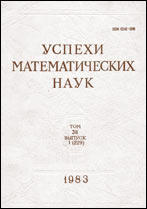|
This article is cited in 4 scientific papers (total in 4 papers)
Problems of value distribution in dimensions higher than unity
I. M. Dektyarev
Abstract:
Consider two $n$-dimensional complex manifolds $X$ and $M$, where $M$ is assumed to be compact. Suppose that on $M$ a form $\omega$ is give, which defines an element of volume, and on $X$ a function $\tau$ with isolated critical points and such that the domain $X_r=\{x:\tau(x)<r\}$ is relatively compact for all $r$. For each point we construct on $M\setminus a$ a form $\lambda_a$ of bidegree $(n-1, n-1)$ with certain special properties which allow us to use a more or less standard techniques to prove the following
“first main theorem”: if a holomorphic map $f:X\to M$ is non-degenerate for at least one point, then
$$
T(r)=N(r, a)+\int_{\partial X_r}d^c\tau \wedge f^*\lambda_a -\int_{X_r}f^*\lambda_a \wedge dd^c\tau,
$$
where $T(r)$ denotes the integral
$\displaystyle\int_0^r\biggl (\int_{X_t}f^*\omega\biggr)\,dt$, and $N(r, a)$ the integral $\displaystyle\int_0^r n(X_t,a)\,dt$; here $n(X_t, a)$ is the number of points (including multiplicities) $x\in X_t$ such that $f(x)=a$.
Under various conditions on the exhaustion $\tau$ and the mapping $f$ we obtain various theorems which assert that when these conditions hold, then the quantity grows for almost all $a\in M$ (over some subsequence of numbers $r$) at the same rate as $T(t)$.
We also consider the case of real manifolds and smooth maps. Here we obtain analogous results, though by different methods.
Received: 12.12.1969
Citation:
I. M. Dektyarev, “Problems of value distribution in dimensions higher than unity”, Russian Math. Surveys, 25:6 (1970), 51–82
Linking options:
https://www.mathnet.ru/eng/rm5427https://doi.org/10.1070/RM1970v025n06ABEH001268 https://www.mathnet.ru/eng/rm/v25/i6/p53
|


| Statistics & downloads: |
| Abstract page: | 383 | | Russian version PDF: | 107 | | English version PDF: | 23 | | References: | 63 | | First page: | 1 |
|




 Contact us:
Contact us: Terms of Use
Terms of Use
 Registration to the website
Registration to the website Logotypes
Logotypes








 Citation in format
Citation in format 
